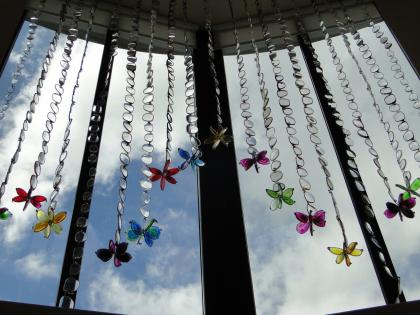 The term ‘starting point’, suggests a single fixed place from where ideas develop. This is an oversimplification of the more complex process of beginning a project. So where does a project begin? Often it begins with the seed of an idea, that perhaps a project could take place. This initiative may come from an artist, a schoolteacher, a youth leader, a group of young people, or an arts institution planning programming ideas. It may begin with a pre existing or new relationship, between artist and group or group leader/teacher. Or it may begin with a need to fulfil certain criteria (an arts institution needing to target new audiences, a class teacher needing to fulfil their curriculum requirements). Artistic, educational or social aims are often outlined in artists’ statements, project proposals or funding applications. These are the early abstract beginnings, the twinkle of the project in its daddy’s eye.
The term ‘starting point’, suggests a single fixed place from where ideas develop. This is an oversimplification of the more complex process of beginning a project. So where does a project begin? Often it begins with the seed of an idea, that perhaps a project could take place. This initiative may come from an artist, a schoolteacher, a youth leader, a group of young people, or an arts institution planning programming ideas. It may begin with a pre existing or new relationship, between artist and group or group leader/teacher. Or it may begin with a need to fulfil certain criteria (an arts institution needing to target new audiences, a class teacher needing to fulfil their curriculum requirements). Artistic, educational or social aims are often outlined in artists’ statements, project proposals or funding applications. These are the early abstract beginnings, the twinkle of the project in its daddy’s eye.
On a more practical level, the beginning of a project is the first session between artist and participants, an initial exercise, or activity, that introduces the theme or medium, and begins the process of exploration which leads to the magic that happens when an artistic project with children or young people begins to come together. The responsibility for this first session and its content almost always falls to the facilitating artist, you will find yourself in a room for the first time with a group of young people or children, looking to you as the artist to initiate something.
This article seeks to excavate the origins of projects I have been involved with, to look at how they begin, and why, and see how these origins relate to the final outcome.
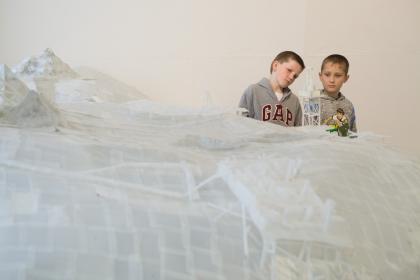
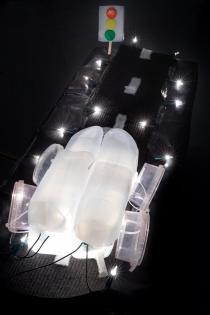 Above: Viewing the work of Ellen Driscoll, Primary Schools Programme 2010-11, Image by Roland Paschoff Right: Cars, St. Joseph’s National School 4th-5th class Christmas exhibition, 2011, Image by Roland Paschoff
Above: Viewing the work of Ellen Driscoll, Primary Schools Programme 2010-11, Image by Roland Paschoff Right: Cars, St. Joseph’s National School 4th-5th class Christmas exhibition, 2011, Image by Roland Paschoff
There are many things to consider when planning the first session of a project, the group, the context, the venue and facilities, the budget and materials, and the artistic content and concept. In my own experience intuition plays a large part. Planning is important, but will only bring you so far. I have been working with children and young people for almost ten years now, and still feel that sense of apprehension, butterflies in my stomach, each time I find myself at the beginning of a project. Whilst I have more confidence in my ability to deliver than in the early days, I still seem to begin each project with various ideas rattling around in my head, never really sure until I’m in the room with the participants quite what we’re going to do.
Working in a gallery-based organisation, using an exhibition of another artist or artists’ work as a starting point for a project is something I am very familiar with. This is the format on which our Primary Schools programme is based. I, or other artists working on the programme with me, are given an exhibition to work with and the initial meeting with each participating group takes place as an exhibition tour followed by practical workshops based on what they’ve seen. The group spends up to 4 hours at WCAC on this first day working with the facilitating artist. From this starting point, the artist works with each teacher to develop projects that suit their group’s age, ability and interests, supported by further workshops in school and resulting in an exhibition of the children’s work.
This approach is externally dictated, both by the institution’s need to link its education and community programme to its exhibitions programme, and by the school’s need to fulfil the looking and responding strand of the visual arts curriculum. As a starting point it originates from neither artist nor participant. I find this a very satisfying way to work, keeping my ideas fresh and challenging me to think anew each time and not fall back on my own interests, and familiar media. I am forced to research new areas, or develop techniques I may not be familiar with, learning along with the participants. It also means that the resulting exhibitions of the children’s work have their own distinct identity each year.
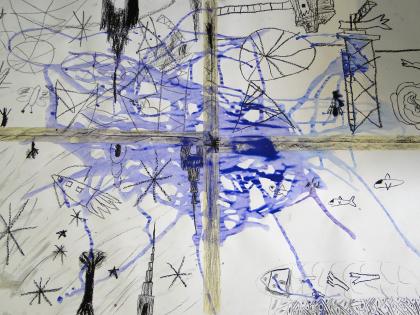
Right: Abbeystrewery National School, From first workshop, Primary schools programme 2010-11
Below: Fields of White Gold, St. James National School Children’s exhibition 2011, Image by Roland Paschoff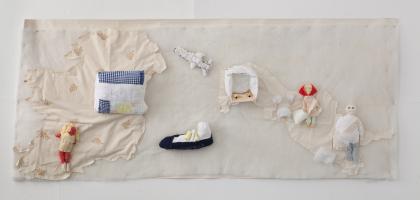
The gallery tour at the start of the first day gives me the opportunity to gauge each group in terms of what they will be capable of and which areas of the exhibition seem to interest them most. I will usually have a number of activities prepared but will not decide which to deliver until we have completed the gallery tour and then need to make a decision about which way to go. This not only keeps me on my toes but also ensures that each schools experience is unique.
The 2010 - 11 programme began with tours of the exhibition fastforwardfossil part 3 by Ellen Driscoll. Although the following practical workshops varied depending on the age and size of the group, there were two key practical activities that nearly all the groups tried in some form. Firstly in response to Ellen’s large drawings of the Whitegate Oil Refinery, the children did their own drawings of things they saw in the gallery, taped them together in groups of four, and dribbled paint around them to reflect Ellen’s use of ink, rain, and chance. This was fun, and allowed them to make a mess in a way many teachers could not accommodate in the classroom, whilst linking directly to the work they’d just seen.
Secondly, all groups got to have a go at making something out of plastic milk bottles, inspired by Ellen’s huge sculpture made entirely from recycled bottles. As an activity requiring a certain degree of practical ability the extent to which they could engage varied according to age. Infants used pre-cut bottles and whole bottles as building blocks, arranging them to create a big group temporary ‘city’. Older classes were able to cut the plastic themselves and attach pieces together using staples, sellotape, or punching holes and tying together.
Each group took this common starting point, provided by the exhibition and initial workshops, and went in their own directions, exploring world trade patterns, local industries and landscapes, recycled materials, and many other things besides. Allowing enough time for a number of practical experiences on the first day gives the teachers plenty of options and ideas to choose from. The final exhibition of the children’s work varied from an installation of sculptures of different forms of transport made entirely from milk bottles and lit from within with fairy lights, to a relief made from recycled fabric exploring the journey of cotton from the fields of Uzbekistan to the consumer in Ireland, and a cardboard, collaged cityscape of Kathmandu.
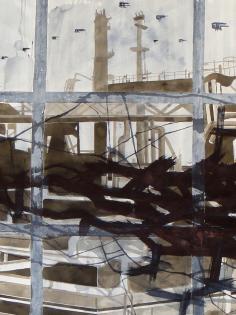
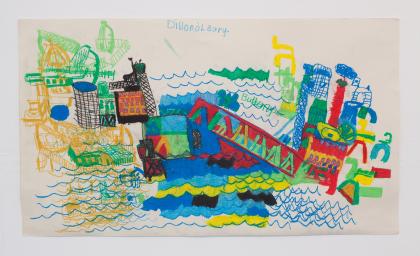
Left: Ellen O’Driscoll, Detail of drawing from fastforwardfossil part 3
Above: Dillon O’Leary, Oil Refinery, Our Lady of Mercy National School children’s exhibition 2011, Image by Roland Paschoff
Many artists use their own practice as a starting point when beginning a new project. This makes sense in that using something you are familiar with, interested in and that enables the group to get to know you better is a constructive place to begin. It gives participants the opportunity to see how you, as an artist, work and think. It is often advantageous to the artist in maintaining cohesion between personal practice and collaborative practice. This starting point originates from the artist.
Starting with the interests of the participants is an approach more commonly taken with teenagers than younger children, as part of what is often called a youth-led approach. This type of project usually requires contact between the artist and participants during the development stages of a project, where, through discussion, a starting point can be established. This starting point originates from the participants; however, it still falls to the artist to decide what will take place during the first practical session. Very often a project is based on finding common ground between the interests of the participants, and the interests, skills and practice of the artist. This is the foundation for a collaborative approach.
The core of our Youth Programme at WCAC is the Friday Night Youth Arts group. An after school group for 13 -18 year olds who come together to work with an artist in a fun and sociable atmosphere to create work for our annual Youth Event. We encourage ownership of the project from within the group and try to allow the participants as much control over the outcome of the project as we can. The group has been running for 7 years and they have worked with a variety of artists over this time. I have found it very interesting to observe the different approaches each artist brings, especially how much the outcomes reflect the work of the artist involved to a greater or lesser degree.
The 2009/10 season of FNYA, with artist Julia Pallone, produced an exhibition called My Mind is a Map. The artwork from this exhibition went on to be part of the Irish exposition at Eksperimenta! the contemporary art triennial for school students, in Tallinn, Estonia. It will also be included in the Young Makers tour of Ireland taking place in 2012. The results of this project have had a fantastic, and unexpected, amount of success and exposure, so where did this project begin?
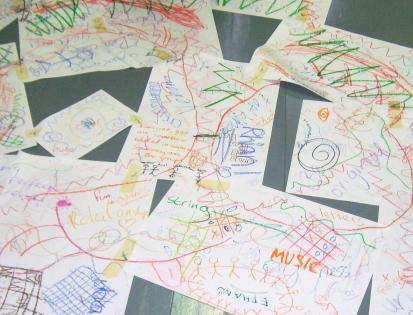
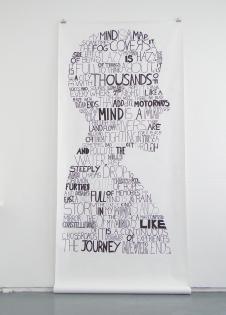
Above: Brainstorming, FNYA first session, 2009, Right: My Mind is a Map, FNYA with Julia Pallone, Youth event 2010
The first workshop of FNYA can be very difficult to plan. In 2009 we began with 15 young people Caoimhe Pendred, workspace assistant, and me. Many of the participants had been involved before but not all. A certain amount of the first session each year is spent, talking, looking at artwork, establishing a group contract, and such like. But still, there needs to be some kind of practical activity.
As a programme that aims to be youth -led we try to give the participants choice over the artist they want to work with. My role in this first session was to break the ice, and get them thinking about a theme ready for the workshops of three guest artists. They would then be able to choose which artist to work with further. As coordinator I planted the seed of the project idea by developing a brief to work with:
This year’s theme will explore the idea of webs, networks and other entanglements. Exploring the formal possibilities of grids, patterns, weaves and mazes as well as different concepts related to these ideas, including possibly, personal relationships, the internet, maps and pathways or any other links the artists or participants may come up with.
The ideal starting point in this situation is a group activity. It takes the pressure off anyone feeling they need to demonstrate individual skills and encourages members of the group to interact. It should be fun; you want the participants to enjoy themselves so they come back the next week. It should be self-contained and have an immediate result, not something that needs to be carried over to the next session. Perhaps this will spark off ideas that lead to the final work, or perhaps it will become irrelevant as other ideas take over. A visual brainstorming session around the theme got their ideas started. The idea of friendship as one of the most important networks in our lives came out of this and we ended up creating an image of the group linked together in a circle, using photographs.
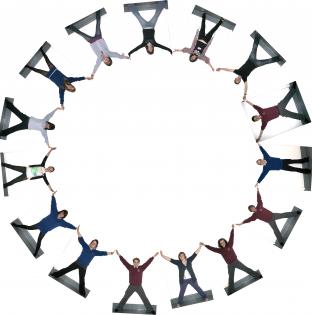
Top: Circle of Friends, From FNYA first session, 2009, Bottom: Shadowlands, FNYA with Julia Pallone, Youth event, 2009
After working with the three guest artists the group chose artist Julia Pallone, whose proposal for her first workshop with them contained the very phrase, My Mind is a Map, that went on to become the final exhibition’s title. Her initial workshop used outlined head images to contain maps, and explored a map of Skibbereen through their own personal stories linked to places in Skibbereen.
Julia used the following quote from Jorge Luis Borges as a starting point:
A man takes on the task of drawing the world. The years pass by; he populates a space with images of provinces, of kingdoms, of mountains, of harbours, of ships, of islands, of fish, of dwellings, of instruments, of stars, of horses, of people. Shortly before his death, he finds out that the patient labyrinth of lines describes the image of his face.
The final exhibition strongly reflected Julia’s starting point, with the work taking these initial ideas in a number of different directions, exploring dreams, imaginary landscapes, and real maps made of memories. Julia’s work has a strong identity, and the influence of this came through most significantly in the paper cut installation Shadowlands. Also interestingly, a project that began with words (the above quote) also ended with words (the text drawing, My Mind is a Map). My initial workshop had served its purpose of breaking the ice, and introducing a theme, with Julia’s first contact with the group providing the germ of the ideas from which the project grew, drawing heavily on her own art practice.
In contrast to FNYA many of our youth outreach programmes begin with an already formed group. I will visit the group, show them some projects we’ve done before, and talk with them about the possibilities. I will then go away and look for an artist who I think would be able to fulfil what they have said they are interested in. This is possible because the group already has an independent existence outside the project, and they will carry on as a group doing whatever they normally do, while I go away and seek funding. Once the project begins the artist is there to fulfil a role, they already know where the group’s interests lie, however once again it is down to the artist to design the first session, to find a starting point relevant to the groups interest from which to begin.
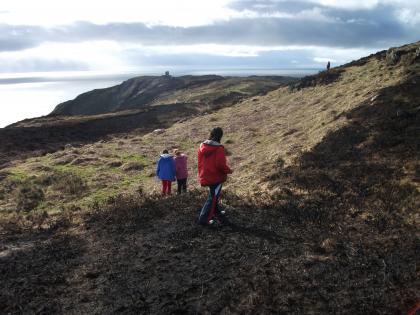
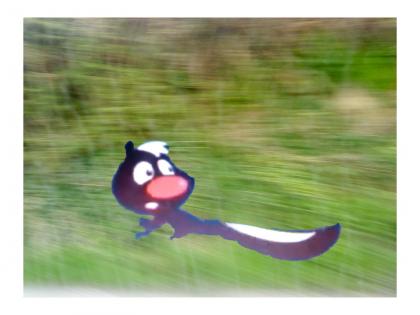
Top: An early image documenting the Cape Clear project, Right: Aodh O’Drisceoil, still from Skunk sa fíor domhain, Oileán exhibition 2010
Photographer Eoin O’Conaill worked with the young people of Cape Clear Island in 2009/10 as part of our outreach programme, funded by the National Youth Council of Ireland, Udarás na Gaeltachta and Ealaín na Gaeltachta. Eoin was chosen after I met the group and they expressed a strong interest in photography as a medium. The project was a collaboration in which the artist would contribute his skills in photography, helping the group to develop their own work, and the participants would contribute their knowledge of the island, helping Eoin to explore the community and landscape and develop his own body of work based on the island community. The resulting exhibition displayed Eoin and the participant’s work alongside each other. Here Eoin describes his first session with the group:
The aim of the first session was to get the group to think about ideas or their interests that they might like to make a photographic project on. As my main area of focus is documentary photography - the young people may have had more experience or contact with landscape photography of the Island and the traditional view of the residents and crafts etc rather than the everyday reality of life on the island. What I wanted to show was that there are ways of using photography to tell a story about their lives and the way they live - ordinary narratives that can show a new perspective of life on Cape and allow the young people to look at their lives in a new way.
What is interesting here is that Eoin began by using his own work (and that of other contemporary documentary photographers that he showed to the group) to demonstrate alternatives to what he saw as the traditional representations of the island, encouraging the participants to look at alternative ways to document their lives. This resulted in many of the participants taking this one step further by creating work that used approaches very different to Eoin’s, including branching out into drawing, animation and video to represent their lives. His initial workshop opened up the boundaries of the project for them straight away.
A Transition Year programme with a group from Mercy Heights Secondary School, Skibbereen, had a more unusual starting point. The project originated from an approach to WCAC from Aiken PR on behalf of Ultralase Ireland, to fund a project that would make use of old pairs of glasses donated by members of the public as a way of raising money for St Vincent de Paul. The starting point for this project came neither from the artist or group but from the materials and site (the final piece was to be for the foyer of the Ultralase clinic in Cork). I identified the transition year group as participants and artist Catherine Ryan was chosen for the project based on her materials based art practice. Due to her lack of experience in working with schools or young people I worked alongside her on the programme in a mentoring role.
Catherine’s first workshop with the group got stuck straight into the raw materials, bags of glasses had to be unpacked, washed and sorted into different types to be easier to deal with. This gave the first session direction, everyone knew what had to be done, and got on with it. To introduce an element of fun, and help us learn the participant’s name, Catherine invited each student to pick a pair of glasses as they sorted through them and decorate them with their name.
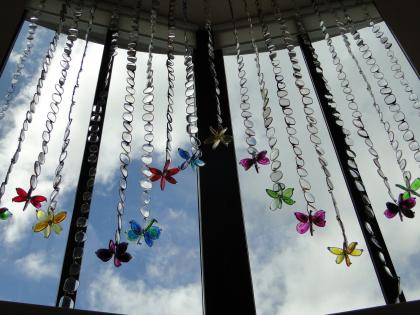
Top: Spectacles, Ultralase TY Project 2010, Bottom: Ultralase installation, Catherine Ryan and TY Mercy Heights 2010
Her honest description, when asked to describe her initial expectations of the project as part of the mentoring report, demonstrates the fears and doubts many of us experience when faced with a new project with many unknowns ahead.
Excited and challenged and maybe a little apprehensive!
I was excited by the initial idea of the project; the collection of glasses for charity and then the use of those glasses as a material for a sculptural piece, and by the prospect of working with teenagers and the WCAC.
Using the material and working with such a large group was going to be a challenge especially as I had very little experience working with this age group and in such a formal setting as a school. Apprehensive, as I was afraid I would not engage with the students, they would not be interested or would lose interest, find the project boring.
I was unsure as to how much guidance or direction I would need to provide or would be expected from me. What were the expectations of the students? Should I have a very definite idea or would the students have their own ideas? Would I have the necessary skills to bring the project to completion?
There is no straight line between where a project begins and ends, looking back we can see the connections, but before those first workshops, when the artist is on their own, looking for somewhere to set out from the path is not so clear. Catherine’s doubts were proven wrong, she did have the skills to complete the project successfully. The very practical, materials based start reflected her own art practice, and the resulting tone of the project, in which there was much work to be done on a practical level and everyone got involved.
Each of these examples demonstrates a different approach to the beginning of a project and how those early beginnings linked to the final outcome. The Primary Schools Programme begins with an exhibition, and ends with an exhibition in the same space 5 or months later. From similar experiences at WCAC, tailored to the groups needs, that offer a selection of different approaches to the work, the groups are provided with choices, and thus develop the project in ways that interest them. Bringing the work back together at the end highlights the links between the work, and also the many paths that can be taken from one place.
The FNYA, in 2009/10, began initially with a set theme to address, and the need to bond the group. This group were then given choices. They chose a way of working represented by Julia Pallone, using words, thoughts, dreams and simple materials. The resulting work strongly reflected the fact that the group had bought into Julia’s way of working, they had chosen her, chosen this approach and their commitment to this process produced a strong direction to the work.
The Youth Outreach programme allowed the group to dictate the form of the project through their strong interest in photography as a medium. Eoin’s decision to begin by showing the group alternatives, and opening the boundaries for them, resulted in the participants producing work that ended up moving away in many cases, from the media they themselves had chosen.
The Transition Year programme began with the materials, and proved to be a very practical and materials based activity, with the group become almost a factory production line of sorting, cleaning, removing arms, painting and fixing together to achieve their aims.
What is common to all these projects is that all of the artists experience doubts similar to those expressed by Catherine Ryan. Will I be able to achieve this? How will the group respond? Will they get on board with these ideas I’m bringing to them? Is what I’m planning for this first session going to set us up in the right way for the rest of the project? And they all achieved their aims, with the first workshop developing into a worthwhile project, producing successful outcomes reflecting the beginnings they had grown from.
Alison Cronin, Practice.ie Guest Editor December 2011/January 2012

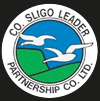
No comments added